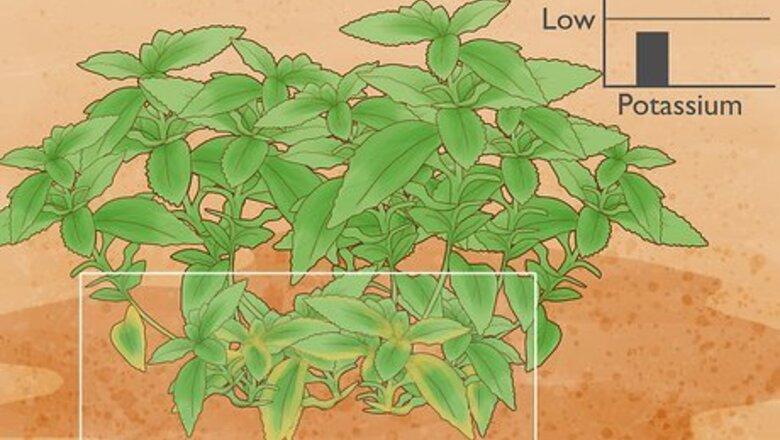
views
X
Research source
Potassium is essential for helping your plants fight disease and grow strong, healthy roots. It can also make your plants more resistant to drought.[2]
X
Research source
If you suspect your plants have a potassium deficiency, get a soil sample for testing, since this is the best way to tell if your plants could benefit from potash. Choose a potash fertilizer and apply it based on the test results and the specific needs of your plants.
Knowing When to Use Potash
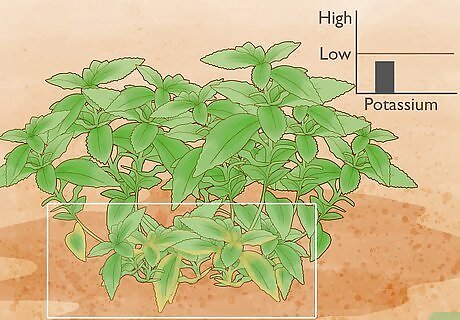
Check for yellowing leaf edges to spot a potassium deficiency. In many types of plants, a potassium deficiency will cause the edges of leaves near the bottom of the plant to turn yellow or brown. Over time, the leaves higher up on the plant will also be affected. Get your soil tested for a potassium deficiency if you notice these distinctive symptoms in your plants. In alfalfa plants, you might notice white or yellow spots appearing around the edges of older leaves. Potassium deficiency is especially hard on potato plants in the summer, when the tubers start bulking up. You might notice the leaves turning brown and shriveling at the edges, and the vines will eventually start to die back.

Send a soil sample to your local extension office for testing. Getting a soil test is the most reliable way to know if you need to add potash to your soil. Use a clean trowel, spade, or soil probe to collect 6-8 samples of soil from the affected area. When collecting the samples, try to dig down at least 4–6 inches (10–15 cm) deep. Combine the samples together in a clean plastic bucket and mix them thoroughly. Contact your local agricultural extension office for instructions about how to package the soil sample and submit it for testing. If you don’t have an agricultural extension office in your area, you may be able to get your soil tested by a local nursery or horticultural society. Get your soil tested if you suspect a potassium deficiency in your established crop or garden, or if you’re preparing to plant an area and want to check the nutrient balance first. In the U.S., a basic soil test costs about $7-10 for one sample.Tip: Most of the time, you should get your test results within 1-2 weeks. However, it might take longer for you to get your results during the late fall through early spring, since there’s more demand for soil testing during those times.

Use potash if the tests show a potassium deficiency. Your soil test results should provide details about any nutrient deficiencies and specific recommendations about fertilizing your plants. If the tests indicate that there’s not enough potassium in the soil for your plants, get a potash or high-K fertilizer and apply it according to the recommendations in the test results. If you’re not sure how to interpret the test results, contact a horticulture specialist or talk to someone at your local agricultural extension office. Different types of plants need different amounts of potassium in the soil. In general, however, your plants will benefit from a potassium boost if your soil’s potassium content is 80 ppm (parts per million) or lower. The test results should include recommendations about when to apply the fertilizer and how much to use within a given area.
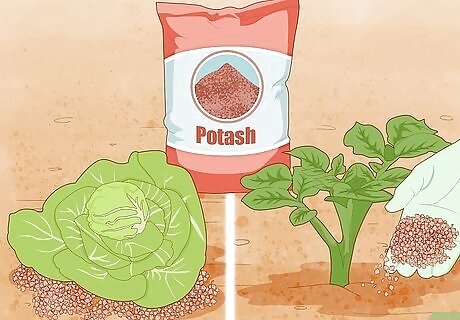
Feed potassium-hungry plants, like potatoes and sugar beets, with potash. All plants need potassium, but some require more than others. If you’re growing root vegetables, like potatoes or sugar beets, they’ll need extra potassium to support their big, tuberous roots. Cruciferous vegetables like cauliflower and cabbage also benefit from lots of potassium. Corn, carrots, and alfalfa also need plenty of potassium to thrive.
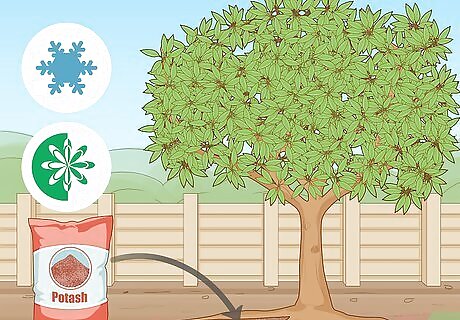
Fertilize fruit trees with potash in winter and spring to prevent disease. Potassium is important for protecting plants from diseases, such as anthracnose fungus. Fruit trees can be especially prone to these types of infections. To prevent your fruit from being spoiled by fungus, add potash fertilizer to the soil around the trees in late winter and early spring, when new leaves and flowers are starting to emerge. Many fruit trees can benefit from monthly potash treatments in winter and spring. Check with a plant specialist at your local nursery or agricultural extension office for more guidance on the specific needs of your trees.
Selecting a Potash Fertilizer
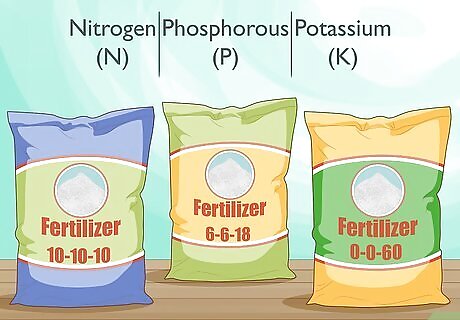
Choose a high-K fertilizer for high potassium content. Most fertilizers are N-P-K fertilizers. These 3 letters refer to the elements nitrogen (N), phosphorous (P), and potassium (K). Fertilizers are typically labeled with 3 numbers that indicate the percentages of these elements in the fertilizer, always in the same order. Look for a fertilizer with a high “K” number if you need more potassium. For example, a 10-10-10 fertilizer will contain a balanced mixture of nitrogen, phosphorous, and potassium, while a 6-6-18 fertilizer has a relatively high potassium content. A potash-only fertilizer will typically be 0-0-60 or 0-0-50. When you look at a bag of fertilizer, you can see three letters on it, N, P, and K. They refer to the percentage of Nitrogen, Phosphorus, and Potassium, the most important nutrients to add to the soil.
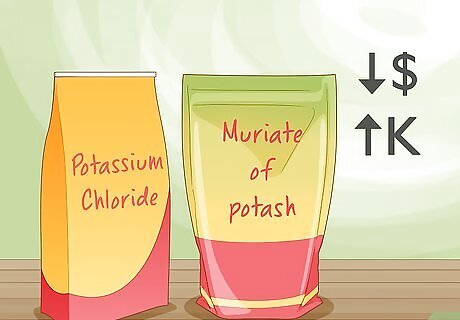
Select potassium chloride for a low-cost, high-K option. Potassium chloride, also known as muriate of potash, is the most commonly used type of potash fertilizer. Choose this option if you need a high concentration of potassium and want a low-cost, readily available form of potash. You can buy potassium chloride fertilizer at most home and garden supply centers or purchase it online. Look for products labeled “muriate of potash” or “potassium chloride.”
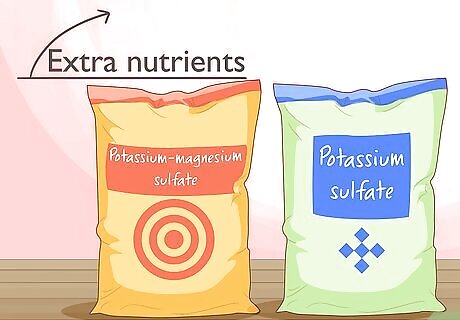
Get potassium sulfate or potassium-magnesium sulfate for extra nutrients. If soil tests show that your plants could also benefit from extra sulfur or magnesium, potassium sulfate or potassium-magnesium sulfate fertilizers may be a good option. Consider using this type of fertilizer for crops such as corn, alfalfa, and potatoes, which can benefit from extra sulfur and magnesium as well as potassium. Potassium sulfate fertilizer is sometimes called sulfate of potash. You can buy these fertilizers online or from a home or garden supply center. These fertilizers tend to be more costly than potassium chloride fertilizers. They also contain lower concentrations of potassium.
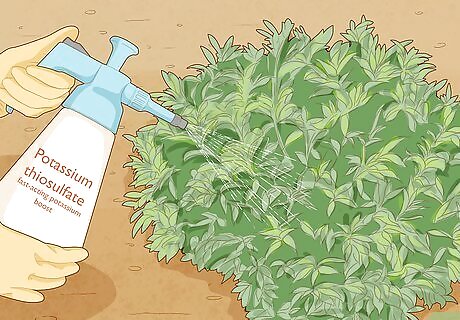
Use potassium thiosulfate if you need a fast-acting potassium boost. If your plants are suffering from a potassium shortage and need a supplement that works fast and is easily absorbed, liquid potassium thiosulfate fertilizer can be very helpful. Add it to your plants’ water supply (fertigation) or spray it directly onto the leaves (foliar application) to give your plants a boost. Potassium thiosulfate is more expensive than other sources of potassium. It’s also a shorter-acting fertilizer, so you will need to apply it more frequently. Potassium thiosulfate is available online or from plant supply stores.
Applying Potash

Check with your local extension office for advice on when to apply potash. The best time to apply potash depends on the types of plants you’re growing, local weather conditions, and the type of soil you have. Before using potash, contact your local agricultural extension office, horticultural society, or plant nursery for advice. Some plants, such as corn, benefit the most from a potash application at the time of planting. Other plants do better if you add the potash before you plant the seeds. You may need to apply potash as a top dressing once a year to some established perennial crops or plants, such as alfalfa or grass. Apply fertilizer at the right time. Spring is the perfect time to apply fertilizer. Do not add nitrogen in the fall. It can stimulate leaf growth and make the plants susceptible to frost damage. While fall and spring are the most common times for potassium applications in the soil, some farmers or gardeners opt to add potassium in the winter so that it’s available for the plants when they start to grow in the spring.
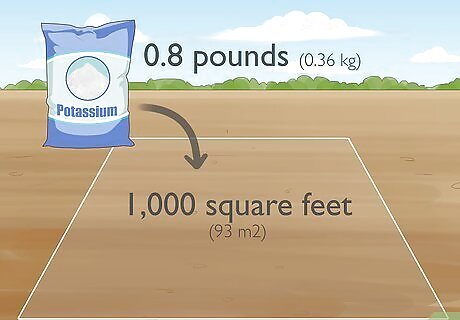
Measure out the amount of potash you need based on soil test results. Use your soil test result recommendations as a guide to determine how much potash you need to apply to a given area. For example, your results might recommend that you use 0.8 pounds (0.36 kg) of potassium per 1,000 square feet (93 m) in your garden. Calculate the area of your garden and the amount of potassium in your fertilizer to figure out how much to apply.Tip: If you’re using an N-P-K fertilizer, figuring out the amount you need based on the ratio of nutrients in the fertilizer can be tricky. To make it easier, try using a fertilizer management calculator like the ones available here: http://soiltesting.tamu.edu/webpages/calculator.html. You can find the area of your garden by multiplying its length by its width. Multiply the amount of potash you need per 1,000 square feet (93 m) by the area of your garden divided by 1000. If you have a 200 sq ft (19 m) garden, you’d need 0.8 pounds (0.36 kg) of potash X ⁄1000 square foot (0.0186 m) = 0.16 pounds (0.073 kg) of potash. A 0-0-60 fertilizer is 60% potash and 40% filler, so you’ll need to do another calculation to figure out how much of the fertilizer to apply. Divide the amount of potash you need by the percentage in your fertilizer. For example, 0.16/.6 = 0.27 pounds (0.12 kg) of your 0-0-60 fertilizer for a 200 sq ft (19 m) garden.
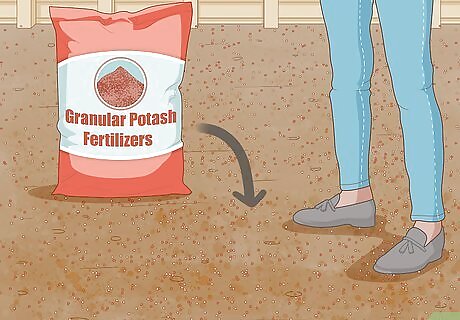
Apply granular potash fertilizers directly on top of the soil. If you’re using a solid form of potash, such as potassium chlorate or potassium sulfate, apply it as a topdressing before planting or mix it into the top layer of soil near your seeds at planting time. The easiest way to apply it is with a fertilizer broadcaster, a wheelbarrow-like device that spreads the fertilizer onto the soil. Take care to spread the fertilizer evenly, moving in 2 different directions so that you get good coverage across the area. While some gardeners and farmers recommend tilling potash into the soil to get it closer to the root zone, it is typically cheapest and easiest to apply it to the surface of the soil.
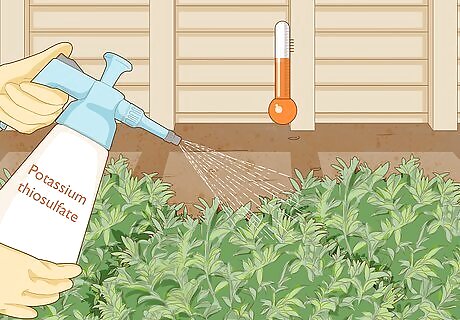
Spray potassium thiosulfate on the leaves during the growing season. Liquid potassium thiosulfate fertilizer can give your plants a great boost if they’re suffering from a potassium deficiency during the growing season. Spray it directly onto the leaves according to the directions on the package. Don’t use potassium thiosulfate to fertilize seedlings or add it to the soil, since it can damage your plants when used this way. Don’t apply potassium thiosulfate to your plants’ leaves if it’s hotter than 90 °F (32 °C) outside. High temperatures cause the small pores on the surface of the leaves to close, so your plants won’t absorb the nutrients if it’s too hot.















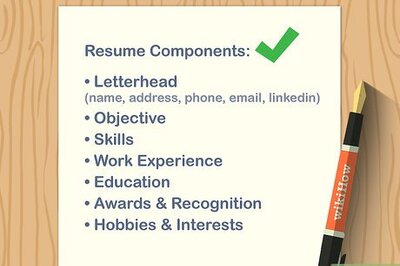

Comments
0 comment